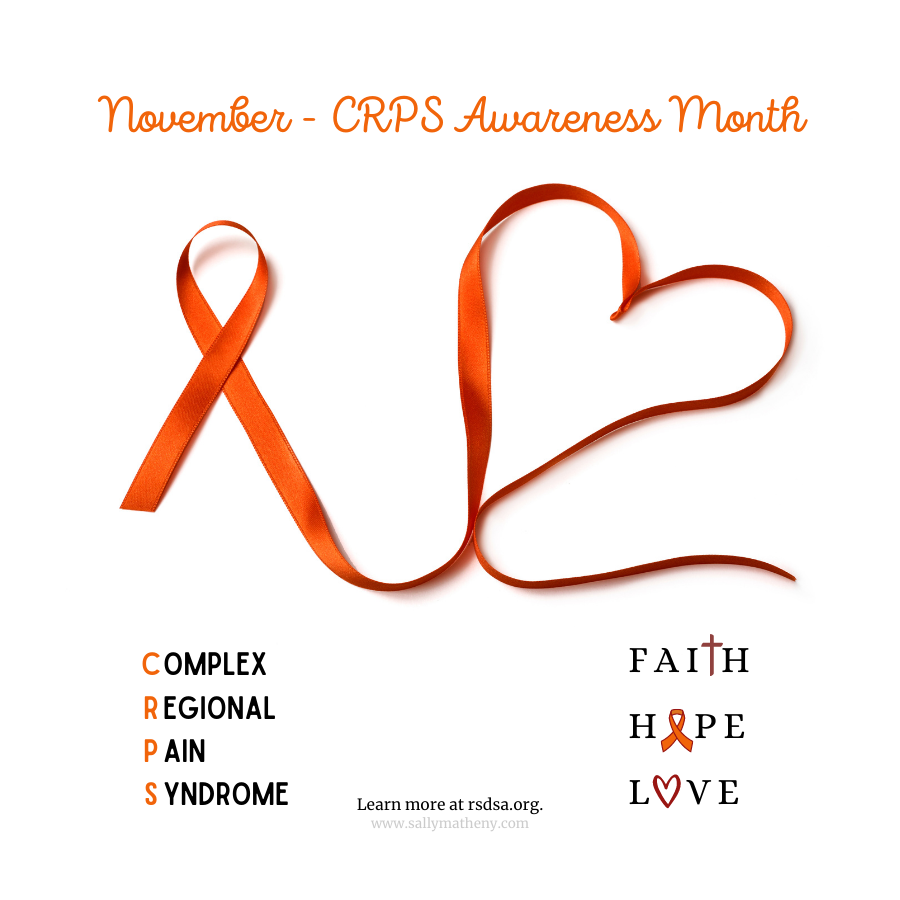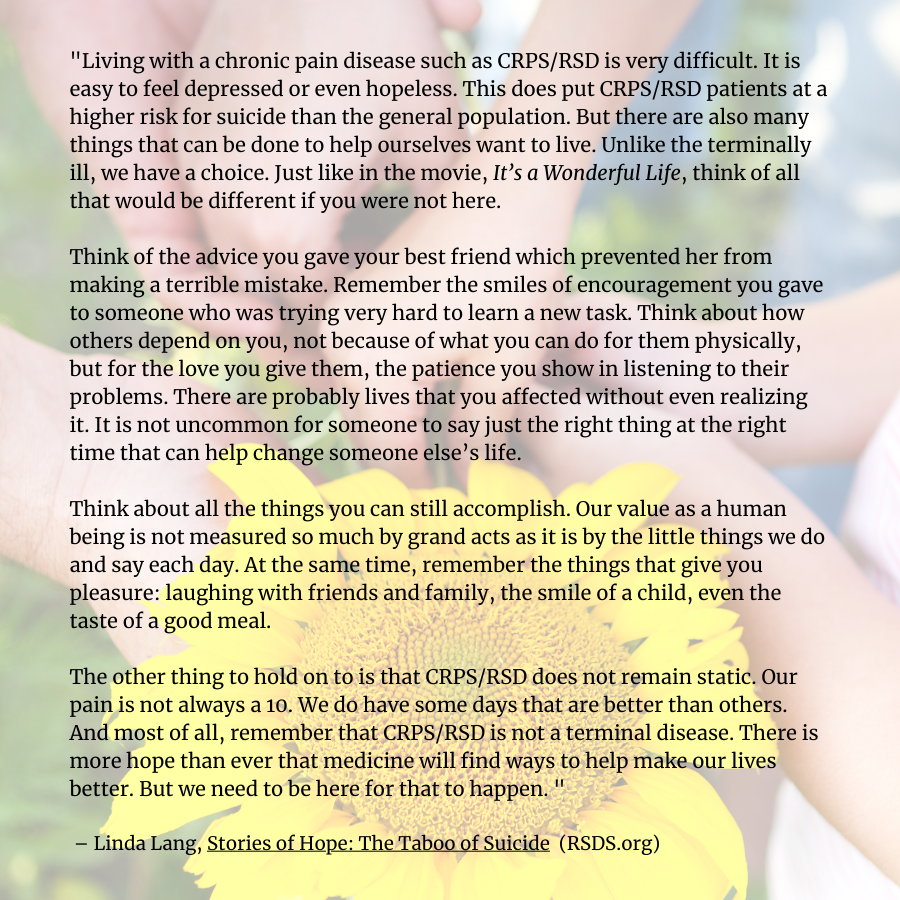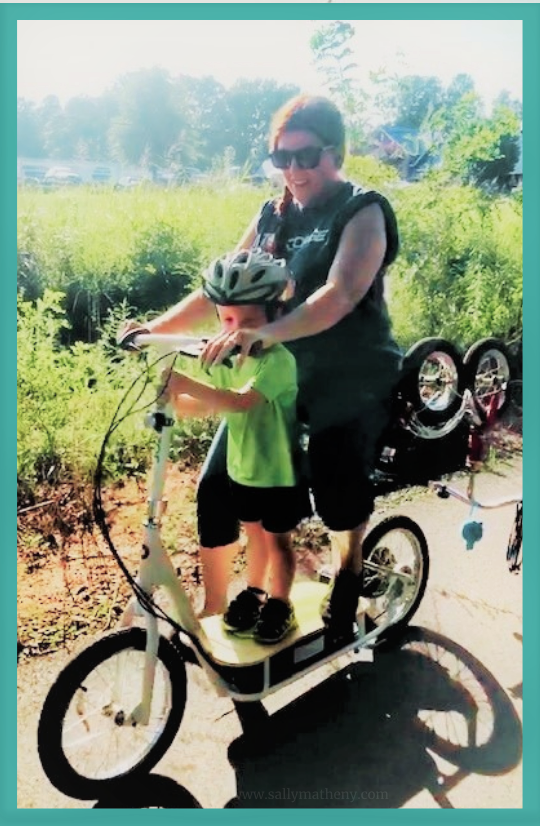
CRPS Awareness: Chronic Pain Requires Courage
Chronic pain requires courage. According to nccih.nih.gov, more than 25.3 million Americans experience chronic pain. Out of those, approximately 200,000 are diagnosed with CRPS (Complex Regional Pain Syndrome). November is CRPS Awareness Month.
Prior to 2014, I had never heard of CRPS. It’s taken me this long to come to terms with this rare, chronic neuroinflammatory disorder. I still don’t fully understand it. Because there are so many CRPS warriors whose suffering is so much greater, I’ve hesitated to even mention mine. However, it is because of those who are suffering greatly, that I want to participate in CRPS Awareness Month.
The form of CRPS that has long-lasting effects is rare. But chronic pain, in general, is not. All chronic pain sufferers, as well as their families, require courage. Courage to search, to identify, and to hope.
What is CRPS/RSD?
The U.S. Food and Drug Administration classifies CRPS, previously known as RSD, as a rare disorder.
The Reflex Sympathetic Dystrophy Syndrome Association (RSDSA) is a national patient advocacy organization which provides information, support, and hope to children and adults affected by Complex Regional Pain Syndrome (CRPS).
“CRPS is a rare, neuroinflammatory syndrome characterized by intense chronic pain, swelling, tropic changes, vascular changes, and functional impairment of the limb. It can become incredibly debilitating unless diagnosed early and treated appropriately.”
“It occurs when the nervous system and the immune system malfunction as they respond to tissue damage from trauma. The nerves misfire, sending constant pain signals to the brain. The level of pain is measured as one of the most severe on the McGill University Pain Scale.”
I’ve read conflicting reports about the average age of those who acquire CRPS. Some say 40, others say between 60-70 years old. I was 49 when it happened to me. Sadly, it does occur in some children and teens.
Because the symptoms can mimic other conditions, many patients see multiple doctors before they’re correctly diagnosed. Fortunately for me, it only took three doctors before being correctly diagnosed with CRPS.
Usually, CRPS occurs after an injury, a surgery, a stroke, or a heart attack. The pain is out of proportion to the severity of the initial injury. CRPS can occur after the smallest incident.
A few weeks after I mildly sprained an ankle, the first odd symptom I felt was like stiff tape wrapped around two toes. I wish it had stayed to just that. However, occasional electrical sensations began zapping throughout my foot.
By the time, I saw my first orthopedic doctor, my foot was so swollen I could barely wear a men’s bedroom slipper (two sizes above my regular size). The painful muscle spasms weren’t near as bad as the waves of hot and cold needle sensations. These were accompanied by various temperature and color changes in my foot which included a peculiar shiny sheen. I didn’t move my foot unless absolutely necessary. My bladder and my foot raged war on who would cave first.
Bewildered by all of this, I knew it was time to search for help.
Courage to Search
Chronic pain sufferers often wonder when they should accept their condition as their “lot in life“ or if they should keep searching for relief. Both options require courage.
When the medical treatment didn’t resolve the initial misdiagnosis ofMorton’s neuroma, my options were either surgery or searching for another doctor. I chose the latter. Finally, I was correctly diagnosed with Type 1 CRPS or CRPS-1.
I was told to seek physical therapy immediately. Apparently, a crucial window of time was about to close which offered the best probability for remission.
In addition, the doctors advised me, since I’d never heard of CRPS, to research about it—“but not too much.” They warned me that reading too much may be more discouraging than helpful.
So, that’s what I did. I sought physical therapy and I only read a handful of articles about CRPS. The doctors were right. Once I began to read a few comments from CRPS warriors, I had to back away. Some of their comments scared me.
While not totally eliminating the pain, physical therapy helped get me back on my feet and in my own size of shoes again. (I love my physical therapy team!)
Occasionally, a setback sends me back to my research–like when my “good” foot decided to become a sympathetic foot and took on the same symptoms.
For me, the key has been to stick to official websites such as those listed on the RSDA website. I limit my reading of personal comments by CRPS warriors. Most of them are in one of the stages of grieving over what they lost due to CRPS. Some of their comments are full of hope, while others are laden with anger or depression. It’s important to remember no two people will experience the same journey with CRPS.
(More information about Types 1 and 2 of CRPS can be found on the Mayo Clinic and NIH websites.
Identify with It but Don’t Let It Define You
Once I was accurately diagnosed with CRPS, I did not want it. I think I went through a period of denial and maybe a little depression. I have grieved over the loss of the ability to run, the lack of freedom to walk without pain, and missing the energy to do the things I long to do.
But, finally, I am at peace about identifying with CRPS. Don’t get me wrong. I am still researching, trying new things, and praying for a cure. I do not wish to wear CRPS as a banner, or become its poster-child. But, I’m okay with saying, “Look, this is how things are at this moment.”
I’m trying to train myself not to say, “My feet hurt,” every time they do, or I’ll drive my friends and family bonkers. But many times, I feel like I must explain why I’m not participating in an event or why I look so hideously exhausted after several sleepless nights due to the CRPS.
Sometimes that is all other people will see—a lack of participation or signs of fatigue. Many CRPS warriors don’t look “sick.” While some are in wheelchairs or use canes, others will only have a mild limp—and even that can vary in appearance depending on the moment’s pain level.
Usually, CRPS occurs in the limbs. It may not be readily apparent, especially if it is in someone’s arm or shoulder. My heart goes out to those who have full-body CRPS. My mind can’t begin to fathom that.
Even if we don’t understand someone’s chronic pain, it’s important to show them compassion. Most of the time, they just need to know we care about them. That doesn’t mean offering them medical advice, telling them to push harder, or dismissing their pain. Scientific studies have proven CRPS is not “all in the head.” The pain is very real. We can offer patience, kindness, and to lift them up in prayer.
Warriors and their families must come to terms with CRPS, but not let it define them.
Courage to Hope
Occasionally, you’ll see CRPS referred to as “the suicide disease.” Sadly, there have been too many CRPS warriors who grew weary of the battle.
However, I recently learned no research has ever been conducted to prove that CRPS in and of itself prompts more suicides than any other condition. Usually, there are other factors that contribute to those decisions.
Linda Lang wrote wise and encouraging words for those living with chronic pain:

(November is CRPS Awareness Month)
There is always hope. New research and treatments for CRPS are always taking place. RSDA just held its first online CRPS conference which provided a lot of new information. CRPS warriors/caregivers were able to connect with others and form new friendships. It always helps to have an encouraging tribe.
My friends and family make a wonderful support team. But, the number one way I find comfort and strength is through God’s Word and the assurance that in His timing, this too shall pass. Jesus is my joy! I encourage all chronic pain sufferers to never give up. God is our strength and our salvation.
Keep Moving Forward
If you have a loved one who suffers from chronic pain, there are things you can do to help them keep moving forward.
For physical and emotional health, it’s imperative for those with CRPS to try and maintain as many normal daily activities as they can. Sometimes they must ask for help, but when possible, let them try whatever they feel they’re able to do.
Pacing activities is also key. If you’re unsure of how this works, you can check out the spoon theory. Be understanding when the spoons run out. Discouragement sets in big time when warriors feel like they are disappointing people.
Help CRPS warriors stay connected with friends and family. For years, I missed biking with my family because of my feet. Then, we invested in a scooter like the kind New Yorkers use for commuting to work. Mine has a seat to take the pressure off of my feet. To be able to get back out with my family did wonders for me. It’s fun, my grandson thinks I’m cool, and now, I’m the fastest one on the trails!
It’s also important to encourage CRPS warriors to pursue interests and hobbies. Even if it means making some adaptations.
In addition to spending time with family and friends, I enjoy writing and I love encouraging others to be strong and courageous. Thus, here I am!

Wear Orange Day – November 2
You can also help CRPS warriors by wearing orange on the first Monday in November.
Help raise awareness about CRPS. Your words may assist someone in getting a correct diagnosis, especially during that critical time of early intervention for remission.
Show compassion to someone with chronic pain. Your kind deeds and encouragement may lift someone’s spirit and remind them of their joy.
Do you have questions about CRPS? I’ll try to answer or find the answer for you. CRPS research and information are constantly growing! My nutshell just wasn’t large enough to hold it.




